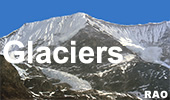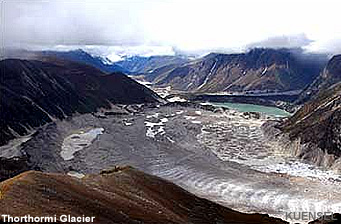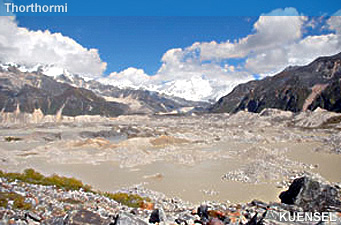| Bhutan's
glaciers and glacial lakes |
 |
Bhutan Glaciers - Glacial Lakes |
|
 |
Bhutan Glaciers - Glacial Lakes |
|
|
 |
|
Lunana's
glacial lakes: Thorthormi Tsho
|
|
Thorthormi Mitigation Project
|
 |
The first phase of an international project to reduce the risk to a Bhutan valley from the threatening bursting of a growing and increasingly unstable glacial lake is emphasising the huge costs of climate change adaptation in the Himalayas.
Thorthormi Tsho is a glacial lake perched precariously at 4,428 metres above sea level in the remote Lunana area of northern Bhutan Rated as one of Bhutan's likeliest future catastrophes, a breach and outburst flood through Thorthormi Tsho's unstable moraine walls would most likely spill into the also vulnerable Raphsthreng Tsho 80 metres below, with the combined flood suddenly releasing up to 53 million cubic metres of water and debris into the upper catchment of the Po Chu river.
In a valley still bearing the scars of a just one third as large 1994 Glacial Lake Outburst Flood (GLOF) which took more than 20 lives and devastated villages and wrecked transport and power facilities, the prospect is frightening.
For Bhutan, scenarios from an outflow from Thorthormi Tsho include crop destruction and livestock losses over more than half of the fertile and economically critical Punakha and Wangdi valleys, loss of a vital bridge and roads, and damage to hydropower facilities under construction. Punakha Dzong, a 14th century royal palace and religious centre, would be among 16 historic monuments at risk, along with numerous other buildings including vocational centres and a noted weekend market.
Monitoring, more intense since the 1994 disaster, tells its own story - Thorthormi Glacier had no meltpools in the 1950s. The new lake has nearly tripled in size since 2001 while the moraine dam holding it has halved its height at the apex over roughly the same period.
The Royal Government of Bhutan (RGB), monitoring the growth of the glacier with Japanese assistance, has sought assistance to reduce the dangers posed by Lake Thorthormi by artificially draining its waters.
A large effort by the government, communities and WWF, supported by the Global Environment Facility (GEF), the United Nations Development Programme (UNDP) and the Austrian Coordination Bureau this year succeeded in lowering the lake level by 86 cm, in the first phase of a project intended to artificially lower the water level at Thorthormi Lake by 5 metres in 3 years.
The Cost of Climate Change: The Story of Thorthormi Glacial Lake in Bhutan is a WWF Living Himalayas Initiative report on the project and the growing risk to Himalayan nations by glacial lake outburst events.
"The story of Thorthormi lake is shaping up to be a story of successful adaptation to climate change," said Tariq Aziz, Leader of WWF's Living Himalayas Initiative. "However, it is also a story of the risks that climate change is building for communities and the costs and complexities of successful adaptation work."
A team of over 300 workers from 20 districts of Bhutan and from all walks of life - tourist guides, farmers, women and yak herders - walked for up to 10 days to reach the site and dig and realign existing outlet channels to safely drain water from the lake. The team braved thin and frigid air and harsh weather conditions including the assault of Cyclone 'Aila' in May 2009. Heavy rains associated with the cyclone damaged access to the site and effort had to be shifted to repairing this.
The bad weather and extreme climatic conditions led to the initial target set for this year of draining 1.67 metres of water being lowered to one metre. When the onset of conditions forced the end of work in October the team had managed to lower the water level by 86 cms. The work will resume in April-May 2010.
"This was less than the target, but nevertheless it has brought down the threat level of the lake bursting in the near future," said Aziz.
The report notes that although Thorthormi Tsho is the largest and most dangerous of the new lakes, some 16 new glaciers and 82 glacial lakes have formed in Po Chu headwaters alone.
"The speed of the changes, the dimensions of the new risks being faced by communities and the difficulties of securing lives and livelihoods against these threats makes sobering reading," said Kim Carstensen, leader of WWF's campaign to secure a fair, effective and binding global climate deal at Copenhagen summit in just two weeks time.
"This gives some perspective to the calls for substantial funding for climate change adaptation in the developing world. It also underlines how vital it is to come to an agreement to reduce emissions, reduce the extent of climate change and reduce the loss of life and livelihoods in areas that have contributed very little to the problems they now face."
The WWF Living Himalayas Initiative report also gives information on glacial lakes and glacial lake outburst floods (GLOFs), potentially dangerous lakes in the Himalayas and the threats from them including destruction they are likely to cause in case of outbursts.
| Source:
WWF 2009 |
 |
| Information |
 |
| Links |
 |
 |
 |
External
link |
 |
 |
 |
 |
 |
| GRID-Arendal
News |
NASA's
Global Change Master Directory |
United
Nations Environment Programme |
World
Glacier Monitoring Service |
International
Centre for Integrated Mountain Development |
|
 |
 |
 |
|
|




